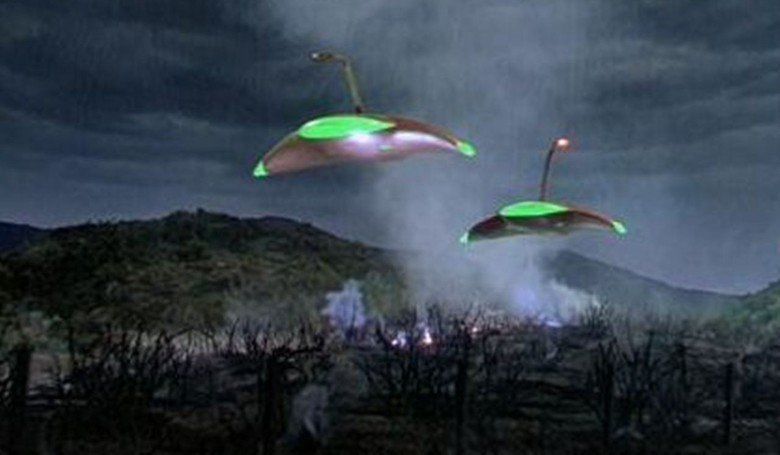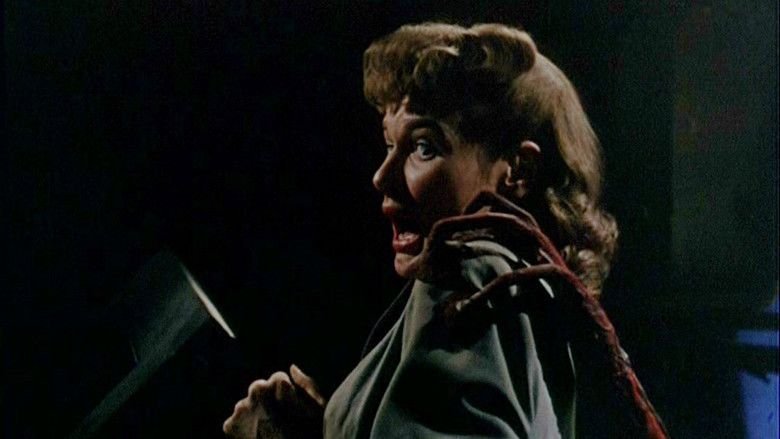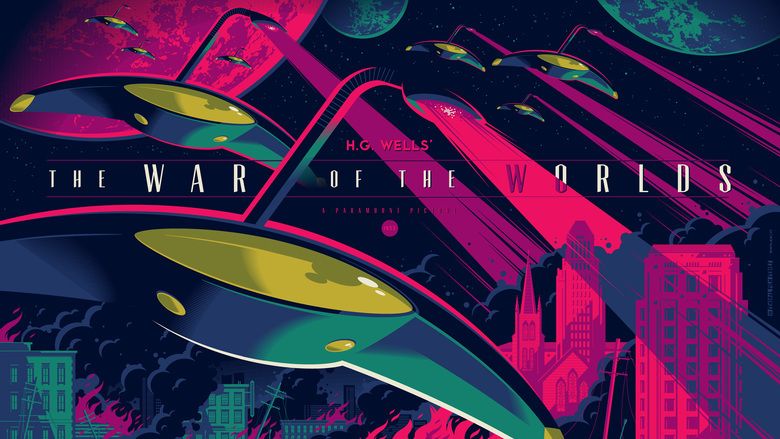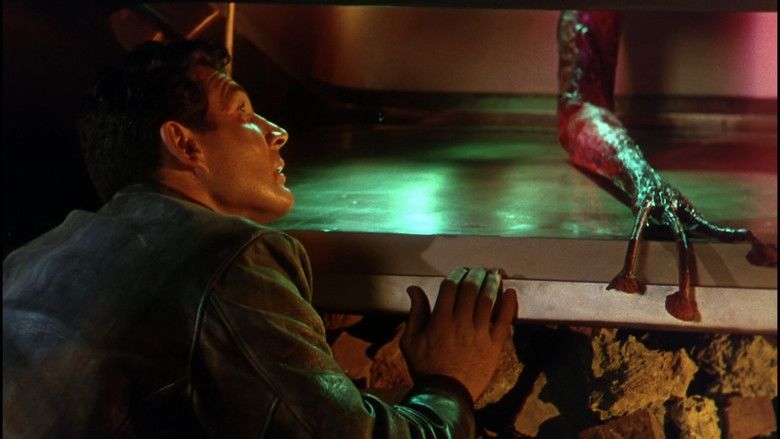The War of the Worlds (1953 film)
7 /10 1 Votes
Duration Language English | 7/10 IMDb Genre Action, Sci-Fi Country United States | |||||||||||||||||||||||||||||||||
 | ||||||||||||||||||||||||||||||||||
Release date August 26, 1953 (1953-08-26) Based on The War of the Worlds by H. G. Wells Writer H.G. Wells (novel), Barre Lyndon (screenplay) Cast (Dr. Clayton Forrester), (Sylvia Van Buren), (General Mann), Robert O. Cornthwaite (Dr. Pryor), Sandro Giglio (Dr. Bilderbeck), (Pastor Dr. Matthew Collins)Similar movies Independence Day , Star Wars: Episode V - The Empire Strikes Back , Aliens , Star Wars: Episode VI - Return of the Jedi , Edge of Tomorrow , The Avengers Tagline Amazing! terrifying! The most savage spectacle of all time! | ||||||||||||||||||||||||||||||||||
The War of the Worlds (also known in promotional material as H. G. Wells' The War of the Worlds) is a 1953 American Technicolor science fiction film from Paramount Pictures, produced by George Pal, directed by Byron Haskin, that stars Gene Barry and Ann Robinson.
Contents
- 1953 the war of the worlds
- Plot
- Production
- Differences from the Wells novel
- Music
- Title Sequence
- Special effects
- Release
- Critical reaction
- Legacy
- References

The film is a loose adaptation of novel of the same name by H. G. Wells, the first of five film adaptations. It is a modern retelling of the 1897 novel, changing the setting from Victorian Era England to 1953 southern California, while also being a commentary on the then-ongoing Cold War and the nuclear arms race. Earth is suddenly and unexpectedly invaded by Martians and American scientist Clayton Forrester searches for any weakness that can stop them.

The War of the Worlds won an Academy Award for Best Visual Effects and went on to influence other science fiction films. In 2011, it was selected for preservation in the United States' National Film Registry in the Library of Congress, being deemed "culturally, historically, or aesthetically significant".

1953 the war of the worlds
Plot

In southern California, Dr. Clayton Forrester, a scientist who had worked on the Manhattan Project, is fishing with colleagues when a large object crashes near the town of Linda Rosa. At the impact site, he meets Sylvia Van Buren and her uncle, Pastor Matthew Collins. Later that day, the "cylinder" opens and the inhabitants of the ship kill a welcoming party, simultaneously shutting down all technology in the town with an electromagnetic pulse. The United States military surround the crash site in battle formation as reports pour in of identical objects landing all over the world and destroying cities. Collins attempts to make peace with the Martians before being killed himself. The Martian war machines effortlessly defeat the military with a "Heat-Ray".

Attempting to escape, Forrester and Sylvia hide in an abandoned farm house. They begin to develop romantic feelings for each other before the house is buried by yet another cylinder. They encounter and dismember an "electronic eye" from the Martian machine, and collect a blood sample from a Martian wounded by Forrester to protect Sylvia. They manage to sneak away from the aliens without being seen. Many of the major capitals of the world are destroyed in the attacks and the United States government makes the decision to use nuclear weapons against the invaders. Forrester brings the Martian camera and blood samples to his team at Pacific Tech, with hope they can study the technology. An attempt to destroy a camp of Martians by nuclear strike fails due to the integrity of their shields, but Forrester remains hopeful they can fight the Martians by studying the blood samples and finding a biological weakness.

As the Martians advance on Los Angeles, with nothing left to fight them, the city is evacuated and many of the inhabitants are forced to live in the wilderness. Forrester, Sylvia and the Pacific Tech team are split apart by looters and their scientific equipment is stolen or destroyed. Forrester searches for Sylvia in the city while the Martians cause widespread destruction. Based on a story she had told him earlier, he deduces that she would be hiding in a church. After searching through a couple of churches, he finds Sylvia in the third among many praying survivors. Just as the Martians strike the church, their machines suddenly crash. Forrester finds the pilot of one such machine dead, and notes that they were "all praying for a miracle". It is revealed by the radio announcer/narrator that while the Martians were impervious to humanity's weapons, they had "...no resistance to the bacteria in our atmosphere to which we have long since become immune. Once they had breathed our air, germs, which no longer affect us, began to kill them. The end came swiftly. All over the world, their machines began to stop and fall. After all that men could do had failed, the Martians were destroyed and humanity was saved by the littlest things, which God, in His wisdom, had put upon this Earth..."
Production

The War of the Worlds opens with a black-and-white prologue featuring newsreel war footage and a voice-over describing the destructive technological advancements of Earthly warfare from World War I through World War II. The image then smash cuts to vivid Technicolor and the dramatic opening title card and credits which follow (see "Title Sequence" section below).

The story then begins with a series of color matte paintings by astronomical artist Chesley Bonestell depicting the planets of our Solar System (all except Venus). A narrator (Sir Cedric Hardwicke) offers a tour of the hostile environment of each world, eventually explaining to the audience why the Martians find our lush, green and blue Earth the only world worthy of their scrutiny and coming invasion.
This is the first of two adaptations of Wells' classic science fiction filmed by George Pal; it is considered to be one of the great science fiction films of the 1950s.
George Pal originally planned for the final third of the film to be shot in the new 3D process to visually enhance the Martians' attack on Los Angeles. The plan was dropped prior to actual production of the film, presumably being deemed too expensive. World War II stock footage was used to produce a montage of destruction to show the worldwide invasion, with armies of all nations joining together to fight the invaders.
Dr. Forrester's and the other scientists' "Pacific Tech" ("Pacific Institute of Technology") has since been referenced in other films and television episodes whenever directors/writers/producers needed to depict a science-oriented California university without using a specific institution's name.
The California city of Corona was used as the shooting location of the fictitious town of Linda Rosa. St. Brendan's Catholic Church, located at 310 South Van Ness Avenue in Los Angeles, was the setting used in the climactic scene where a large group of desperate people gather to pray. The rolling hills and main thoroughfares of El Sereno were also used in the film.
On the commentary track of the Special Collector's DVD Edition of War of the Worlds, Robinson and Barry point out that the cartoon character Woody Woodpecker is seen in a tree top, center screen, when the first large Martian meteorite-ship crashes through the sky near the beginning of the film. Woody's creator Walter Lantz and George Pal were close friends. Pal tried to always include the Woody character out of friendship and good luck in his productions, noted Joe Adamson years later, "Walter had been close friends with Pal ever since Pal had left Europe in advance of the war and arrived in Hollywood."
A 1988 sequel was produced for a network television series of the same name.
Differences from the Wells novel
As noted by Caroline Blake, the film is very different from the original novel in its attitude toward religion, as reflected especially in the depiction of clergymen as characters. "The staunchly secularist Wells depicted a cowardly and thoroughly uninspiring Curate, whom the narrator regards with disgust, with which the reader is invited to concur. In the film there is instead the sympathetic and heroic Pastor Collins who dies a martyr's death. And then the film's final scene in the church, strongly emphasizing the Divine nature of Humanity's deliverance, has no parallel in the original book."
Pal's adaptation has many other notable differences from H. G. Wells' novel. The closest resemblance is probably that of the antagonists. The film's aliens are indeed Martians, and invade Earth for the same reasons as those stated in the novel (the state of Mars suggests that it is in the final stages of being able to support life, leading to the Martians decision to make Earth their new home). They land in the same way, by crashing to the Earth. However, the novel's spacecraft are large cylinder-shaped projectiles fired from the Martian surface from some kind of cannon, instead of the film's meteorite-spaceships; but the Martians emerge from their craft in the same way, by unscrewing a large, round hatch. They appear to have no use for humans in the film. In the novel, however, the invaders are observed "feeding" on humans by fatally transfusing their captives' blood supply directly into Martian bodies by using pipettes; there is also a later speculation about the Martians eventually using trained human slaves to hunt down all remaining survivors after they have conquered Earth. In the film the Martians do not bring their fast-growing red weed with them, but they are defeated by Earth microorganisms, as observed in the novel. However, they die from the effects of the microorganisms within three days of the landing of the first meteorite-ship; in the novel the Martians die within about three weeks of their invasion of England.
The Martians themselves bear no physical resemblance to the novel's Martians, who are described as bear-sized, roundish creatures with brown bodies, "merely heads", with quivering beak-like, V-shaped mouths dripping saliva; they have sixteen whip-like tentacles in two groupings of eight arranged on each side of their mouths and two large "luminous, disk-like eyes". Due to budget constraints, their film counterparts are short, reddish-brown creatures with two long, thin arms with three long, thin fingers with suction cup tips. The Martian's "head", if it can be called that, is a broad "face" at the top-front of its broad shouldered upper torso, the only apparent feature of which is a single large eye with three distinctly colored lenses (red, blue, and green). The Martians' lower extremities, whatever they may be, are never shown. (Some speculative designs for the creature suggest the idea of three thin legs resembling their fingers, while others show them as bipeds with short, stubby legs with three-toed feet.)
The film's Martian war machines do actually have more of a resemblance than they may seem at first glance. The novel's machines are 10-story tall tripods and carry the heat-ray projector on an articulated arm connected to the front of the war machine's main body. The film's machines are shaped like manta rays, with a bulbous, elongated green window at the front, through which the Martians observe their surroundings. On top of the machine is the cobra head-like heat-ray attached to a long, narrow, goose-neck extension. They can be mistaken for flying machines, but Forrester states that they are lifted by "invisible legs"; in one scene, when the first machine emerges, you can see faint traces of three energy legs beneath and three sparking traces where the three energy shafts touch the burning ground. Therefore, technically speaking, the film's war machines are indeed tripods, though they are never given that designation. Whereas the novel's war machines had no protection against British army and navy cannon fire, the film's war machines have a force field surrounding them; this invisible shield is described by Forrester as a "protective blister".
The Martian weaponry is also partially unchanged. The heat-ray has the very same effect as that of the novel. However, the novel's heat-ray mechanism is briefly described as just a rounded hump when first seen in silhouette rising above the landing crater's rim; it fires an invisible energy beam in a wide arc while still in the pit made by the first Martian cylinder after it crash-lands. The film's heat-ray projector when first seen is shaped like a cobra's head and has a single, red pulsing "eye", which likely acts like a targeting telescope for the Martians inside their manta ray-like war machine. The novel describes another weapon, the "black smoke" used to kill all life; the war machines fire canisters containing a black smoke-powder through a bazooka-like tube accessory. When dispersed, this black powder is lethal to all life forms who breathe it. This weapon is replaced in the film by a Martian "skeleton beam", green pulsing bursts fired from the wingtips of the manta-ray machines; these bursts break apart the sub-atomic bonds that hold matter together on anything they touch. These skeleton beams are used off screen to obliterate several French cities.
The plot of the film is very different from the novel, which tells the story of a 19th-century writer (with additional narration in later chapters by his medical student younger brother), who journeys through Victorian London and its southwestern suburbs while the Martians attack, eventually being reunited with his wife; the film's protagonist is a California scientist who falls in love with a former college student after the Martian invasion begins. However, certain points of the film's plot are similar to the novel, from the crash-landing of the Martian meteorite-ships to their eventual defeat by Earth's microorganisms. Forrester also experiences similar events like the book's narrator: an ordeal in a destroyed house, observing an actual Martian up close, and eventually reuniting with his love interest at the end of the story. The film is given more of a Cold War theme with its use of the Atomic Bomb against the enemy and the mass-destruction that such a global war would inflict on mankind.
Music
The composer of the film score, Leith Stevens, also composed two other scores for Pal productions: Destination Moon and When Worlds Collide.
Title Sequence
The title sequence is dynamic and martial. Military stenciling flashes repeatedly in changing colors, fast dissolves, and swipes of various shapes, all against an unchanging black background. Following a montage of scratched footage from both World Wars showing the evolution of weaponry, accompanied by a voice-over call to arms by voice actor Paul Frees in an solemn, adamant voice, the Leith Stevens’ martial score begins with a crash and flaring horns as “The War of the Worlds” in brilliant Technicolor red military stencil lettering appears in a smash cut, rising in a second to fill the screen; then the lettering changes into green followed by a circular iris swipe that reveals yellow stenciling “Based on the novel by H.G. Wells”; another circular swipe reveals the cast names in green, which then flash yellow rapidly then back to green; a horizontal swipe from the left reveals in pastel blue stencil “Screenplay by Barré Lyndon”; followed by a swipe revealing rich dark blue lettering listing technical crew; another vertical swipe from the top with pulsating, flashing purple letters with more crew; another swipe from the top showing in flashing orange and yellow stenciling the composer and associate producer; another swipe with flashing red letters reveal the special effects artists; swipe again this time with flashing red and white letters “Produced by George Pal” right into “Directed by Byron Haskin.”
Special effects
The War of the Worlds won an Academy Award for Best Visual Effects and was later selected for inclusion in the National Film Registry of the Library of Congress. An effort was made to avoid the stereotypical flying saucer look of UFOs: The Martian war machines (designed by Al Nozaki) were instead made to be sinister-looking machines shaped like manta rays floating above the ground. Three Martian war machine props were made out of copper for the film. The same blueprints were used a decade later to construct the alien spacecraft in the film Robinson Crusoe on Mars, also directed by Byron Haskin; that film prop was later reported melted down as part of a scrap copper recycling drive. (The model the late Forrest Ackerman had in his massive, now dispersed Los Angeles science fiction collection was a replica made using the Robinson Crusoe on Mars blueprints; it was constructed by friends Paul and Larry Brooks.)
Each Martian machine was topped with an articulated metal neck/arm, culminating in the cobra-like head, housing a single electronic eye that operated both like a periscope and as a weapon. The electronic eye also housed the Martian heat ray, which pulsed and fired red sparking beams, all accompanied by thrumming and a high-pitched clattering shriek when the ray was used. The distinctive sound effect of the weapon was created by an orchestra performing a written score, mainly through the use of violins and cellos. For many years, it was utilized as a standard ray-gun sound on children's television shows and the science-fiction anthology series The Outer Limits, particularly in the episode "The Children of Spider County".
The machines also fired a pulsing green ray (referred to as a skeleton beam) from their wingtips, generating a distinctive sound, also disintegrating their targets, notably people; this second weapon is a replacement for the chemical weapon black smoke described in Wells' novel. This weapon's sound effect (created by striking a high tension cable with a hammer) was reused in Star Trek: The Original Series, accompanying the launch of photon torpedos. Another prominent sound effect was a chattering, synthesized echo, perhaps representing some kind of Martian sonar; it can be described as sounding like hissing electronic rattlesnakes.
When the large Marine force opens fire on the Martians with everything in its heavy arsenal, each Martian machine is protected by an impenetrable force field that resembles, when briefly visible between explosions, the clear jar placed over a mantle clock; cylindrical and with a hemispherical top. This effect was accomplished by the use of simple matte paintings on clear glass, which were then photographed and combined with other effects, then optically printed together during post-production.
The disintegration effect took 144 separate matte paintings to create. The sound effects of the war machines' heat rays firing were created by mixing the sound of three electric guitars being recorded backwards. The Martian's scream in the farmhouse ruins was created by mixing the sound of a microphone scraping along dry ice being combined with a woman's recorded scream and then reverse-played for the sound effect mix.
There were many problems trying to create the walking tripods of Wells' novel. It was eventually decided to make the Martian machines appear to float in the air on three invisible legs. To show their existence, subtle special effects downward lights were to be added directly under the moving war machines; however, in the final film, these only appear when one of the first machines can be seen rising from the Martian's landing site. It proved too difficult to mark out the invisible legs when smoke and other effects had to be seen beneath the machines, and the effect used to create them also created a major fire hazard. In all of the subsequent scenes, however, the three invisible leg beams create small, sparking fires where they touch the ground.
Release
The War of the Worlds had its official Hollywood premiere on February 20, 1953, although it did not go into general theatrical release until the autumn of that year. The film was both a critical and box office success. It accrued $2,000,000 in distributors' domestic (U.S. and Canada) rentals, making it the year's biggest science fiction film hit.
Critical reaction
The New York Times review of The War of the Worlds noted, "[The film is] an imaginatively conceived, professionally turned adventure, which makes excellent use of Technicolor, special effects by a crew of experts, and impressively drawn backgrounds ... Director Byron Haskin, working from a tight script by Barré Lyndon, has made this excursion suspenseful, fast and, on occasion, properly chilling." "Brog" in Variety felt, "[It is] a socko science-fiction feature, as fearsome as a film as was the Orson Welles 1938 radio interpretation...what starring honors there are go strictly to the special effects, which create an atmosphere of soul-chilling apprehension so effectively [that] audiences will actually take alarm at the danger posed in the picture. It can't be recommended for the weak-hearted, but to the many who delight in an occasional good scare, it's socko entertainment of hackle-raising quality."
The War of the Worlds won an Academy Award for Special Effects (it was the sole nominee that year), while Everett Douglas and Loren L. Ryder were nominated for Film Editing and Sound Recording respectively.
The War of the Worlds still receives high acclaim from critics: At the review aggregator website Rotten Tomatoes, the film has an 85% rating based on 27 critics; the consensus states: "Though it's dated in spots, The War of the Worlds retains an unnerving power, updating H. G. Wells' classic sci-fi tale to the Cold War era and featuring some of the best special effects of any 1950s film".
Legacy
The War of the Worlds was deemed culturally, historically, or aesthetically significant in 2011 by the United States Library of Congress and was selected for preservation in the National Film Registry. The Registry noted the film's release during the early years of the Cold War and how it used "the apocalyptic paranoia of the atomic age." The Registry also cited the film's special effects, which at its release were called "soul-chilling, hackle-raising, and not for the faint of heart."
The 1988 War of the Worlds TV series is a sequel to the Pal film; Ann Robinson reprises her role as Sylvia Van Buren in three episodes. Robinson also reprises her role in two other films, first as Dr. Van Buren in 1988's Midnight Movie Massacre and then as Dr. Sylvia Van Buren in 2005's The Naked Monster. In Independence Day, invading aliens are defeated in part by infecting the mothership with a computer virus. There are also several other allusions to Pal's 1953 War of the Worlds: the failed attempt of a dropped atomic bomb is replaced with a nuclear armed cruise missile launched by a B-2 Spirit bomber (a direct descendant of the Northrop YB-49 bomber used in the 1953 film) and Captain Hiller being based in El Toro, California, which Dr. Forrester mentions as being the home of the Marines, which make the first assault on the invading Martians in Pal's film.
The Asylum's 2005 direct-to-DVD H. G. Wells' War of the Worlds has mild references to the Pal version: Inside the Martian's mouth, they have three tongues that closely resemble the three Martian fingers seen in the Pal film. The Asylum film also includes scenes of power outages after the aliens' arrival via meteorite-ships. As in the Pal film, refugees are seen hiding in the mountains instead of hiding underground, as in the Wells novel and the protagonist actively tries to fight the aliens by biological means.
Steven Spielberg's 2005 War of the Worlds, although an adaptation of the original Wells novel, does feature several references to the original film: Gene Barry and Ann Robinson have cameo appearances near the end, and the invading aliens have three-fingered hands but are depicted as reptile-like, three-legged walking tripods. There is also a long, snake-like alien camera probe deployed by the invaders in much the same manner as in the 1953 film.
Mystery Science Theater 3000 named one of its lead characters, the mad scientist Dr. Clayton Forrester, as a homage to the 1953 film.
References
The War of the Worlds (1953 film) WikipediaThe War of the Worlds (1953 film) IMDb The War of the Worlds (1953 film) themoviedb.org
